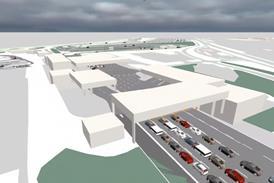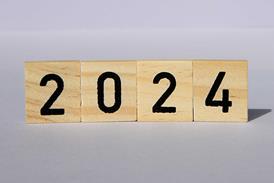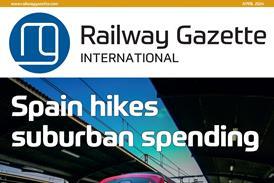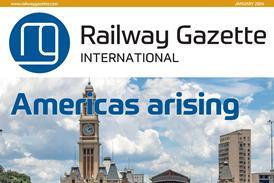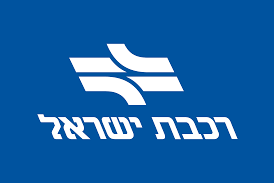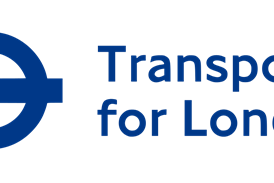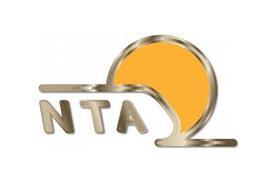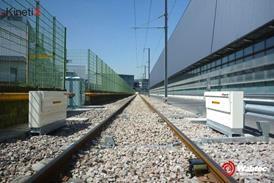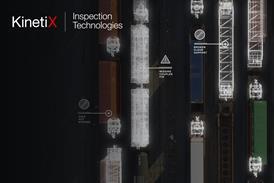IN 1995-98 Metro de Madrid's extension team successfully added no less than 56·3route-km to the network. The same team, working under the Regional Minister for Public Works Luis Eduardo Cortés, is now directing a 1999-2003 expansion plan of similar proportions. Headed by Metro de Madrid President Manuel Melis, the tunnelling crews are at work 24h a day on a 5·9 km extension to Line 8 that should enable passengers to travel from Nuevos Ministerios to Barajas Airport in 12min from the start of 2002. Later in that year an 8·3 km extension of Line 10 to Alcorcón is due to open, connecting the centre of Madrid with a completely new ring metro serving the rapidly-growing southern suburbs.
Metro de Madrid's Director of Projects & Works Ildefonso de Matías sees the 40·5 km Metrosur project as the star of the 1999-2003 programme, and its impact on the network is likely to be substantial. Metrosur is expected to carry up to 140000 passengers a day during its first year of operation, as 80% of the 1million people living in Alcorcón, Móstoles, Fuenlabrada, Getafe and Leganés will be within 600m of one of 27 new metro stations or a stop on the four RENFE suburban routes that cross or touch Metrosur with five interchanges.
Line 10 is being upgraded for its new role as Metrosur's connection to the rest of the network, and this includes widening tunnels and cutting back station platforms on older sections of the route to accommodate wide-profile (2800mm) cars in place of the 2300mm wide stock used at present. Platforms are to be lengthened from 90m to 120m for six-car trains and the traction power supply is to be raised from 600V DC to 1·5 kV DC. Since June 1 2000 Line 10 has been closed between Campamento and Gregorio Marañón to allow civil contractors FCC and Ferrovial Agroman to tackle Alonso Martínez, Tribunal, Plaza de España, Lago and Bat? n stations, and this work is expected to be finished in the first quarter of 2001. This contract also includes 1·2 km of new construction, and a new station at Puerta de Bat? n where Line 10 will interchange with Line 5.
The Madrid model
Construction methods for the 1999-2003 expansion programme will follow those used for the 1995-1998 extensions (MR 98 p46), where 38 km of 9·4m diameter tunnels were bored using six earth pressure balance TBMs. Cut and cover using diaphragm walls was employed for 7·9 km of running tunnels and stations, with 5·7 km dug by hand. Tunnelling costs were US$16·6m/km, out of a total average cost including rolling stock of $44·4m/km for the 1995-98 programme.
Looking to apply the lessons of Madrid to metro projects in Latin America through an urban transport strategy review due for completion by the end of 2000, the World Bank has described these costs as 'substantially below the levels that were internationally considered possible'. As President of Metro de Madrid and Director General of Transport Infrastructure for the Madrid regional government, Manuel Melis says that the 'undoubted success' of the 1995-98 programme was due to the clear and decisive impulse given by minister Cortés, with decisions being taken within 24h, as well as 'careful consideration and implementation of engineering principles and practices'.
Melis does not believe in appointing external project managers, saying that 'you lose months' with separate contracts for construction and supervision. Typically, Metro de Madrid aims to open a new line for service three weeks after fitting-out has been completed. 'Within a month the trains are running', says Melis, who for the 1995-98 works headed a team of nine engineers from the regional government. They were assisted by four geotechnical specialists, and by Metro de Madrid staff on electrical and mechanical works.
Open-face tunnelling methods such as NATM were discarded primarily on safety grounds, but also with regard to the serious financial and political consequences of any tunnel collapse and the delays it would engender. The extension team worked on TBM specifications with suppliers Herrenknecht and Mitsubishi-NFM to develop four machines, each with a total thrust of 10000 tonnes. At work on Line 8 between July 17 1998 and February 23 1999, a Mitsubishi TBM recorded an average daily advance of 16·1m, achieving a record of 39m on one occasion. Ground and structure movement was closely monitored at 8225 points throughout Madrid.
Another ingredient in Madrid's recipe for success has been the careful selection of tunnelling contractors. 'A well-executed tunnelling project is an art', says Melis, 'the client should be prepared to spend the necessary time in choosing the artist'. In evaluating tenders, cost considerations represented 30% of the total weighting. The proposed timescale for completing the contract accounted for 20%, with the remaining 50% made up by the technical content of the bid and its staffing provisions. Each accompanied by separate technical assistance and quality control contracts, the 14 civils contracts for the 1995-98 programme were let on a fixed price basis, but incorporating a mechanism for pricing and agreeing any additional work.
Cutting maintenance costs
As with tunnelling techniques, the 1999-2003 expansion programme will follow its predecessor by making full use of innovations in track, traction power supply and signalling that Metro de Madrid hopes in time to roll out across the existing network. The use of a concrete trackbed and resilient fastenings is now well established for plain line, and it is intended to use the same system for switches and crossings. With the latter accounting for some 80% of track maintenance costs, Director of Projects & Works Ildefonso de Matías reports that work is under way to develop lubrication-free points.
Installed on the new lines of the 1995-98 programme and on Line 2 between Ventas and Banco de España, rigid catenary with an aluminium conductor rail will be a feature of Lines 8, 10 and 12, and should be installed on 110 km of Metro de Madrid routes by 2003. De Matías describes its performance as 'fantastic', highlighting reduced maintenance requirements and an absence of hard spots, but recognises that Metro de Madrid will be breaking new ground in using rigid catenary at up to 110 km/h. This will be the maximum speed on the new and upgraded routes of the 1999-2003 programme, where the line voltage will be 1·5 kV DC, in contrast to Metro de Madrid's traditional 60 km/h and 600V DC. All new substations are being designed for 1·5 kV DC, which should enable a more intensive service to be provided despite the higher power requirements of new air-conditioned rolling stock.
Reducing the track and catenary maintenance workload has already helped to bring down operating costs from Pts439m per train-km in 1995 to Pts349m in 1999, while over the same period staff numbers have fallen from 5627 to 5291. Further savings are expected from maintenance tools currently under development, including a PC-based geographic information system that combines track quality data with digital images of the track and tunnels. Cameras and 11 track quality sensors (mainly accelerometers fitted at bogie and body level) and have been installed in service trains to gather this data, which it is eventually hoped to update on a weekly basis.
Signalling strategy
With the exception of Lines 2 and 5, all Metro de Madrid routes are equipped for ATO, which displays a maximum speed in the train cab. The resignalling of Line 10 (RG 8.00 p466) to provide headways of 120 and eventually 90sec will retain fixed blocks, but will govern train operation on the basis of distance to go. Level 1 of the European Rail Traffic Management System may be adapted to provide ATO and ATP for Metrosur, which is expected to open with three-car trains operating at 5min intervals.
Although interoperability on main line networks is the main driver for ERTMS, de Matías says that 'standardisation will bring benefits for all', hopefully in the shape of cheaper, standardised signalling products such as Eurobalises. For data transmission, de Matías thinks that Madrid would adopt Tetra digital radio using leaky feeders rather than GSM-R, about which he has reliability concerns. Madrid has joined fellow metro operators in Berlin, Lisbon, London and Paris in the UGTMS project, which with suppliers Adtranz, Alcatel, Alstom, Ansaldo, Invensys and Siemens/Matra is looking to develop common signalling and ATP standards for 2005.
Mirroring the Madrid tunnelling philosophy, de Matías is anxious that only proven signalling technology is used in projects due for completion in 2003. In this context, moving block is 'risky', but both on-board and trackside equipment for Line 10 will be designed for its possible introduction. Moving block will probably be needed first to raise capacity on the older cut-and-cover routes such as Lines 1, 3 and 4, where platform lengthening and conversion to wide-profile trains would be too costly. Dimetronic has been awarded a development contract, and testing within the confines of Canillejas depot on Line 5 may be followed within the next 12 months by trials on Lines 7 and 8.
Rolling stock developments
The rolling stock component of the 1999-2003 expansion plan has three strands. In October 2001, AnsaldoBreda is due to hand over the first of 30 six-car Series 7000 trainsets for Line 10, with deliveries due to follow between December 2001 and December 2002. As well as being the first order placed by Metro de Madrid outside Spain, the Series 7000 will be the operator's first train with an aluminium bodyshell, riding on equally innovative flexible two-piece bogies.
A consortium of CAF, Siemens, Adtranz and Alstom is building 37 three-car Series 8000 trains for Metrosur, and 10 three-car trains for Line 8. The first train is due to arrive in Madrid for trials in June 2001, with deliveries of the Line 8 trains due for completion in December of that year. As well as full-width gangways and secure storage for luggage checked in at Nuevos Ministerios on Line 8, the Series 8000 will feature a water mist fire suppression system and side ramps for emergency evacuation of the cars in tunnels. Metro de Madrid is at work on a research programme to develop real-time transmission of pictures from on-board CCTV cameras to its Alto del Arenal control centre using Tetra radio.
The Series 8000 building consortium will also deliver 22 Series 6000 trailer cars for Line 9. Refurbishment of Series 5000 cars is also planned, with two prototype vehicles due to be completed by Albatros this summer. Existing auxiliary power supply equipment with be replaced by static converters, and the installation of air-conditioning is likely to be a feature of the programme that Metro de Madrid intends to undertake partly in-house.
Beyond 2003
New lines and other major investment projects beyond 2003 are being considered by the Madrid Regional Transport Authority, with studies for extending Lines 1 and 10 further north already in hand. Line 11 could be extended from its southern terminus at Pan Bendito to meet Metrosur at Leganés or Line 10 further west. From Plaza Elíptica, Line 11 could head northeast to Atocha Renfe, Saenz de Baranda and Ciudad Lineal on Line 5, relieving Line 6 which was Metro de Madrid's busiest in 1999 with 99·4million passenger-journeys.
This northern extension of Line 11 would also provide a second metro route to the major heavy rail interchange at Atocha, where all Renfe routes to the southern and eastern suburbs converge. It is hoped that Metrosur and the extension of Line 10 will divert some 50million passenger-journeys a day from suburban services to Atocha and Renfe's busy cross-city line to Chamartín. Nevertheless, a second heavy rail tunnel between Atocha and Nuevos Ministerios, via Sol and Alonso Martínez, is seen as a priority by Melis in his capacity as Director General of Transport Infrastructure for the regional government.
The growing network
TABLE: 1995 1999 2003
Route-km 120 176 233
Number of stations 164 202 240
Passenger journeys, million 397 480 -
1999-2003 extension programme
TABLE: Line Section Length Stations Start of Completion Budgeted km civil works time months cost 1 Pts m
8 Nuevos Ministerios - Mar de Cristal 5·9 2 10/01/00 28 35400
10 Alonso Martínez - Puerta de Bat? n 2 1·2 1 04/04/00 30 12900
10 Puerta de Bat? n - Alcorcón 7·1 3 04/04/00 30 30300
12 Metrosur 40·5 27 23/05/00 32 195600
1. Including rolling stock.2. Construction of new station at Puerta de Bat? n and widening of loading gauge at Alonso Martínez, Tribunal, Plaza de España, Lago and Bat? n
- CAPTION: The Puerta de Arganda - Arganda del Rey route was built by the TFM consortium with private finance, and is operated as an extension of Line 9 by Metro de Madrid which has a 42·5% stake in the group. Two-car Series 6000 trainsets operate at up to 110 km/h through open countryside awaiting suburban development
- CAPTION: Operational since July 26 2000, the metro control centre at Alto del Arenal brings together traffic control, passenger information, security and power supply functions. Station equipment including ticket vending machines and gates is monitored, with ticket usage across the network updated every 10min
- CAPTION: Aeropuerto station on Line 8 features rigid catenary and a concrete trackbed. This route is currently operated with the latest build of Series 2000 narrow-profile cars, with luggage racks and video screens for passenger information and entertainment
- CAPTION: New lines in the1999-2003 expansion programme make use of proven tunnelling techniques
Extension d'un métro: le modèle madrilène
Le programme 1999-2003 d'extension du métro de Madrid ajoutera 57 km de lignes et 38 stations au réseau, lequel, en 2003, aura presque doublé en taille, par rapport à 1995. Le programme en cours tire parti des leçons des programmes antérieurs, avec lesquels des objectifs de management serrés et une volonté d'utiliser des techniques éprouvées de percement de tunnels, ont permis des travaux à l'heure et dans le cadre du budget prévu. Les coûts d'exploitation diminuent alors que du nouveau matériel roulant, des innovations concernant la voie, la fourniture de courant de traction et la gestion des biens contribuent à réduire la facture de l'entretien
Madrider-Modell leitet Metro-Erweiterung
Das Erweiterungsprogramm 1999-2003 der Metro de Madrid bringt 57 neue Streckenkilometer und 38 Stationen zum System, welches 2003 beinahe doppelt so gross sein wird wie 1995. Das laufende Programm wendet die Lehren des Vorläufers an, wo klares Management und ein Beharren auf bewährten Tunnelbautechniken die Arbeiten im Zeit- und Budgetrahmen hielt. Die Betriebskosten reduzieren sich, da neues Rollmaterial und Innovationen im Gleisbau, der Stromversorgung und dem Einsatz der Ressourcen die Unterhaltsausgaben senken
El modelo madrileño de expansión del metro
El programa de ampliación 1999-2003 del Metro de Madrid añadir? 57 km de ruta y otras 38 estaciones a su red, lo cual debería haber doblado su tamaño en comparación con 1995. El programa actual est? aplicando las lecciones aprendidas de su predecesor, el cual enfocando estrechamente la gestión e insistiendo en la realización de obras mediante técnicas de tunelaje demostradas garantizó los plazos y presupuesto. Los gastos operacionales est? n disminuyendo gracias al nuevo material rodante y las innovaciones en las vías, en el suministro del corriente para la tracción y en la gestión de activos, todo lo cual ayuda en la reducción de los gastos de mantenimiento




